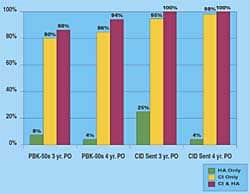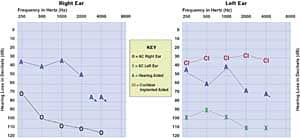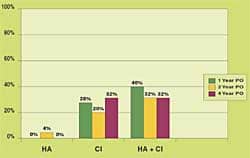In a society where blaring music, roaring vehicles, and loud recreation are an accepted and practically unavoidable part of life, there is a great need to educate children on the dangers of high noise levels. Studies show that hearing conservation practices and knowledge are increased in relation to participating in a hearing conservation program. However, not enough of these programs exist in schools; hearing care professionals need to take up this educational challenge. And there is no need to recreate the wheel when establishing a hearing education program for schoolchildren, because plenty of resources exist. Here’s how to get started.

A recent article in the American Academy of Pediatrics highlights the fact that approximately 5.2 million US children ages 6-19 years are estimated to have noise-induced hearing threshold shifts in one or both ears.1 These temporary shifts can lead to a permanent hearing loss. Add to that the fact that most children aren’t aware about the dangerous effects of noise in relation to their hearing and it is clear that comprehensive educational programs targeting children are needed.
There is precedent for hearing conservation education programs. According to a study done by Chermak, Curtis & Seikel2 in 1996, hearing conservation practices and knowledge were increased in relation to participating in a hearing conservation program. This study was based on a curriculum presented in two 1-hour sessions to two classrooms of fourth-grade students.
Dangerous noise levels not only effect hearing but can also cause psychophysiological stress responses, such as increased blood pressure and epinephrine levels, according to a 1998 study by Evans, Bullinger & Hygge.3 With this information, we as a profession should be pushing to have hearing conservation programs included in school curriculums. In order for this push to take place, documented research and effective programs need to be presented to each state, showing the importance, need, and effects of such programs. Currently, there are programs capable of meeting these goals. Hearing care professionals need to support and encourage the message of hearing conservation in children; we can educate children about the dangers of noise-induced hearing loss by bringing such curriculums into local school districts.
Most children are not aware that excessive amounts of noise-exposure can have dangerous effects on their hearing. This begs the question: As a profession, shouldn’t we be striving every day to educate schoolchildren about the harmful effects of noise?
So, where do you begin, and what, exactly, should you do? Instead of creating your own program, use the expertise of those who have gone before you. This article will give you the necessary steps to begin an effective hearing conservation program for schoolchildren.

From Clinic to Classroom
The earlier children are instructed about hearing loss prevention, the more likely they are to establish good hearing conservation behaviors. Before presenting a hearing conservation program, choose your target audience. Try scheduling your presentation around the time of the children’s hearing screening so they will already have been exposed to the idea of hearing loss before you even set foot in the door. The American Speech Language and Hearing Association (ASHA) recommends that children have their hearing screened annually, starting in kindergarten through third-grade and seventh through eleventh-grade4; however, your state may have other guidelines.
Schools are not likely to allow multiple visits, so maximize your time. Many grade level curriculums require a unit on anatomy. Propose to the school that you will discuss the hearing section of this course with the kids. Choose a curriculum that is age-appropriate to the grades in which the anatomy section is taught.

What’s Needed and Where to Find It
A comprehensive list of recommended hearing conservation programs and activities for children can be found on the National Hearing Conservation Association (NHCA) webpage at www.hearingconservation.org. Once you are on the public education page, you can chose a program that links you to that program’s webpage for more information.
A review on hearing conservation education programs for children can be found in the February 2002 issue of the Journal of School Health. This article by Folmer, Griest & Martin5 not only provides a review of hearing conservation programs, but also gives contact information for all programs listed in the article. A good hearing conservation education program should include:
- Basic information about the auditory system and what happens when it is exposed to loud noises;
- An auditory simulation of hearing loss;
- Specific examples of hazardous noises and how to know when they are too loud; as well as the consequences of hearing loss, and
- Techniques to prevent hearing loss.
Many programs have similar components. For example, the “Unfair Hearing Test” is an auditory simulation of noise-induced hearing loss in which the children are asked to write down what they hear. This type of simulation gives children an idea of what it might be like to have a hearing loss.
Scheduling the Program
The biggest challenge in getting a presentation scheduled in the schools is working around mandatory classroom requirements. Many schools are required to allot certain amounts of time to designated activities such as reading. To overcome this obstacle, you should keep your presentations short. As a general guideline, allow 20 minutes for first through third-grade presentations, and 45 minutes for fourth through twelfth-grade presentations. Programs that require multiple visits to the same classroom are less likely to be approved. Maximize your time at the school by combining classes; however, be careful not to have too many students at one time. Large presentations are not as effective—especially if you have visual and auditory aids. Try to keep the amount of students in each presentation to a minimum: 40 students or less is optimal.
The best way to get into a school is to find someone who is familiar with hearing loss. Persons who have knowledge or experience in this area are more likely to value the importance of your message. Ask for a school nurse, health aid, speech-language pathologist, or educational audiologist. If this avenue does not work, ask for the principal or vice principal. The process to get into a school is often arduous, and it is usually quicker if you are able to contact the person who schedules the campus presentations. Contacting teachers individually is time-consuming and often not advantageous.

Ensuring an Effective Presentation
An effective presentation begins with a good presenter. The lack of individuals in the school system with expertise in hearing conservation presents a problem not only in scheduling but also in the effectiveness of teaching about the dangers of excessive noise. Audiologists usually are good choices to teach such curriculums; however, taking time off from busy schedules can be difficult. Local college undergraduate and graduate students in the field of audiology and speech pathology are an alternative choice for teaching these curriculums.
After the presentation, provide students with a reminder of your visit by giving them something to take home. Furnish a handout during your presentation for children to write down key points. Several curriculums have a “Noise Exposure Thermometer” handout, which gives children examples of noise offenders and how long they can be exposed to those levels before damage begins. For younger students, try using a sticker with essential information such as, “Turn it Down, Walk Away, and Wear Earplugs and/or Earmuffs.”
For older students provide a pair of disposable earplugs. A significant problem people have when using disposable earplugs is not inserting them properly. Before handing out earplugs, a lesson on how to insert them is imperative. “Roll. Pull. Hold” is a short phrase that helps young people remember the proper way to insert earplugs. Handing out earplugs can be costly. To avoid these expenses, contact local industrial supply companies and request a donation. Often supply companies are given a sample box of earplugs by the manufacture and are willing to donate them when asked. If you are unable to procure a donation from the supply companies, go straight to the manufacture and request a donation. Again, seeking individuals who have an understanding of the importance of your message will help to secure a donation.
In addition, provide teachers with a letter explaining your visit to the classroom. Letters should include:
- The dangers of noise in relation to children’s learning;
- Examples of dangerous noise levels in the classroom and at school;
- References for further information on hearing loss and prevention.
Cite specific examples of school-related noise levels such as the cafeteria, recess, and school bus. Educating individuals who live and work with children can foster prevention and understanding.

Reinforcing the Message Through Parental Education
Furthermore, send a parent/guardian letter home with each child, explaining your visit to as well. Include such topics as the effects of noise-induced hearing loss, preventative techniques, and how to know when sound levels are hazardous. Give specific examples of loud activities that may occur at the home, as well as on excursions. Activities such as concerts, monster truck rallies, and car races are a few of the more common choices. Send a message to parents to lead by example. If family members use caution and make efforts to protect their hearing, hopefully their children will follow suit. Parents and teachers need to learn that there is no cure for a noise-induced hearing loss; it is preventable.
There is no need to recreate the wheel when establishing a hearing education program for schoolchildren. Choose a program and begin educating the children of today about the dangerous effects of noise.
| Shannon White, MS, manages a hearing conservation program called Noise Destroys, which has educated over 12,000 students, and is currently working on her CFY in San Diego. |
References
1. Niskar AS, Kieszak MA, Holmes AE, Esteban E, Rubin C, Brody DJ. Estimated prevalence of noise-induced hearing threshold shifts among children 6 to 19 years of age: The third national health and nutrition examination survey, 1988-1994, United States. Pediatrics. 2001;108(1):40-43.
2. Chermak GD, Curtis L, Seikel J. The effectiveness of an interactive hearing conservation program for elementary school children. Language, Speech, and Hearing Services in Schools. 1996;27:29-39.
3. Evans G, Bullinger M, Hygge S. Chronic noise exposure and physiological response: A prospective study of children living under environmental stress. Psychol Science. 1998;9(1):75-77.
4. American Speech-Language-Hearing Association. Guidelines for audiologic assessment of children from birth through 36 months of age. ASHA. 1991; 33 [Suppl]: 37-43.
5. Folmer R, Griest S, Martin WH. Hearing conservation education programs for children: A review. J School Health. 2002;72 (2):51-57.
Correspondence can be addressed to HR or Shannon White, MS, Hearing & Balance Center, 7920 Frost Street, Suite 304B, San Diego, CA 92123; email: [email protected].




